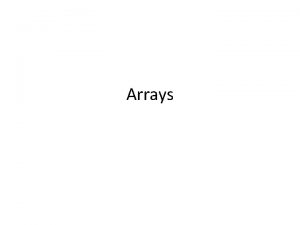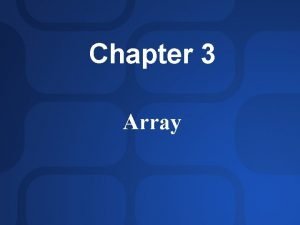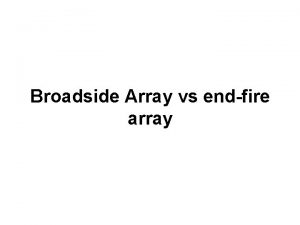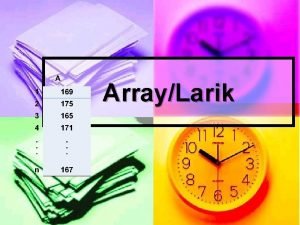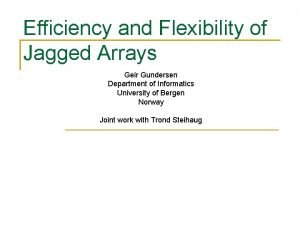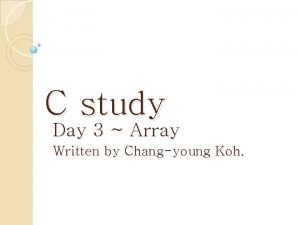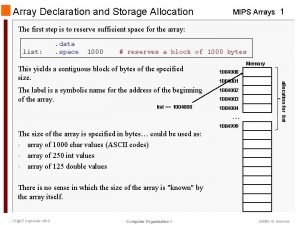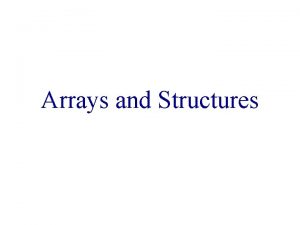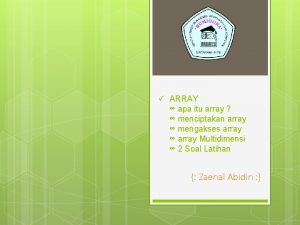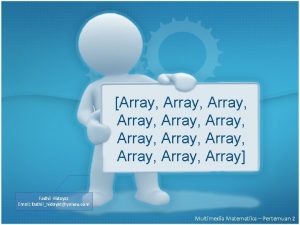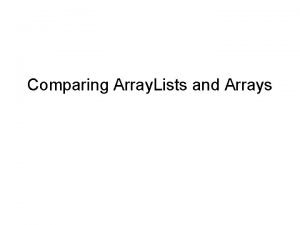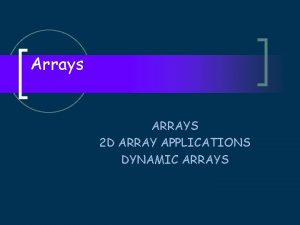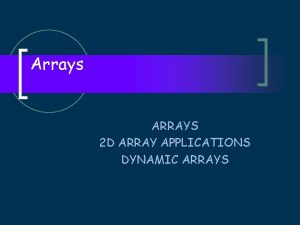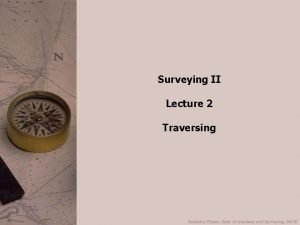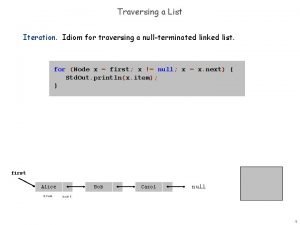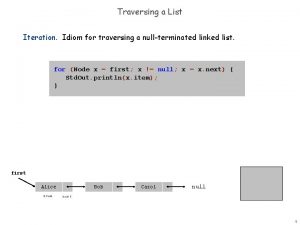Arrays Algorithm for traversing an array Traversing a







![Important points • Arrays can be declared as: AUTO(1932: 1984); where AUTO[K] = value Important points • Arrays can be declared as: AUTO(1932: 1984); where AUTO[K] = value](https://slidetodoc.com/presentation_image_h2/56d0a3fbe29f144b265c1478534cf217/image-8.jpg)


![Q. 2) Given an array A[10, 7] is stored in row major order. An Q. 2) Given an array A[10, 7] is stored in row major order. An](https://slidetodoc.com/presentation_image_h2/56d0a3fbe29f144b265c1478534cf217/image-11.jpg)


![Q. 2) Given an array A[10, 7] is stored in column major order. An Q. 2) Given an array A[10, 7] is stored in column major order. An](https://slidetodoc.com/presentation_image_h2/56d0a3fbe29f144b265c1478534cf217/image-14.jpg)
- Slides: 14

Arrays

Algorithm for traversing an array (Traversing a Linear Array) Here LA is a linear array with lower bound LB and upper bound UB. This algorithm traverses LA applying an operation PROCESS to each element of LA. 1. [Initialize counter] Set K : = LB. 2. Repeat steps 3 and 4 while K <= UB. 3. [Visit element] Apply PROCESS to LA[K]. 4. [Increment counter] Set K : = K + 1. [End of Step 2 loop] 5. Exit.

Algorithm for inserting an element into an array (Inserting into a linear array) INSERT (LA, N, K, ITEM) Here LA is a linear array with N elements and K is a positive integer such that K <= N. This algorithm inserts an element ITEM into the Kth position in LA. 1. [Initialize counter. ] Set J : = N. 2. Repeat Steps 3 and 4 while J >= K. 3. [Move Jth element downward. ] Set LA[J+1] : = LA[J]. 4. [Decrease counter. ] Set J : = J – 1. [End of Step 2 loop. ] 5. [Insert element. ] Set LA[K] : = ITEM. 6. [Reset N. ] Set N : = N + 1. 7. Exit.

Algorithm for deleting an element from an array (Deleting from a linear array) DELETE (LA, N, K, ITEM) Here LA is a linear array with N elements and K is a positive integer such that K <= N. This algorithm deletes the Kth element from LA. 1. Set ITEM : = LA[K]. 2. Repeat for J = K to N – 1 [Move J + 1 st element upward. ] Set LA[J] : = LA[J + 1]. [End of loop. ] 3. [Reset the number N of elements in LA. ] Set N : = N - 1. 4. Exit.

Merging Algorithm • Suppose A is a sorted list with r elements and B is a sorted list with s elements. The operation that combines the element of A and B into a single sorted list C with n=r + s elements is called merging. 5

Merging Algorithm � Algorithm: Merging (A, R, B, S, C) Here A and B be sorted arrays with R and S elements respectively. This algorithm merges A and B into an array C with N=R+ S elements. � Step 1: Set NA=1, NB=1 and NC=1 � Step 2: Repeat while NA <= R and NB <= S: if A[NA] ≤ B[NB], then: Set C[NC] = A[NA] Set NA = NA +1 else Set C[NC] = B[NB] Set NB = NB +1 [End of if structure] Set NC= NC +1 [End of Loop] 6

Merging Algorithm � Step 3: If NA > R, then: Repeat while NB <= S: Set C[NC] = B[NB] Set NB = NB+1 Set NC = NC +1 [End of Loop] else Repeat while NA <= R: Set C[NC] = A[NA] Set NC = NC + 1 Set NA = NA +1 [End of loop] [End of if structure] � Step 4: Return C[NC] 7
![Important points Arrays can be declared as AUTO1932 1984 where AUTOK value Important points • Arrays can be declared as: AUTO(1932: 1984); where AUTO[K] = value](https://slidetodoc.com/presentation_image_h2/56d0a3fbe29f144b265c1478534cf217/image-8.jpg)
Important points • Arrays can be declared as: AUTO(1932: 1984); where AUTO[K] = value at K. • Length = UB – LB + 1 • Address of any element of LA is calculated as: LOC(LA[K]) = Base(LA) + w(K – LB) • Ex: If Base address = 200; w = 4 words, then find address of K=1965 (Ans: 332)

Representation of 2 D array in memory (Row-major) • Let A is 2 D (M x N) array and A[J, K] needs to be found. • Then, for Row-major (with starting index LB 1=LB 2=1): LOC(A[J, K]) = Base(A) + w[N(J - 1) + (K - 1)] Otherwise, LOC(A[J, K]) = Base(A) + w[N(J - LB 1) + (K - LB 2)]

Q. 1) Consider a 2 D array X whose index set of first and second dimensions ranges from -3 to 3 and 2 to 5 respectively (i. e X[-3. . 3 , 2. . 5] a) Find the length of each dimension and size of this 2 D array b) If this array is stored in row major order then find the address of X[1, 3]. Given Base(X)=5000 and w=2 bytes
![Q 2 Given an array A10 7 is stored in row major order An Q. 2) Given an array A[10, 7] is stored in row major order. An](https://slidetodoc.com/presentation_image_h2/56d0a3fbe29f144b265c1478534cf217/image-11.jpg)
Q. 2) Given an array A[10, 7] is stored in row major order. An element A[3, 3] is stored at address 1064 and element A[5, 4] is stored at address 1124. Find the address of A[4, 6] and A[1, 2]?

Representation of 2 D array in memory (Column-major) • Similarly, for Column-major (with starting index LB 1=LB 2=1): LOC(A[J, K]) = Base(A) + w[M(K - 1) + (J - 1)] Otherwise, LOC(A[J, K]) = Base(A) + w[M(K – LB 2) + (J – LB 1)]

Q. 1) Consider a 2 D array X whose index set of first and second dimensions ranges from -3 to 3 and 2 to 5 respectively (ie X[-3. . 3 , 2. . 5] a) Find the length of each dimension and size of this 2 D array b) If this array is stored in column major order then find the address of X[1, 3]. Given Base(X)=5000 and w=2 bytes
![Q 2 Given an array A10 7 is stored in column major order An Q. 2) Given an array A[10, 7] is stored in column major order. An](https://slidetodoc.com/presentation_image_h2/56d0a3fbe29f144b265c1478534cf217/image-14.jpg)
Q. 2) Given an array A[10, 7] is stored in column major order. An element A[3, 3] is stored at address 1064 and element A[5, 4] is stored at address 1124. Find the address of A[4, 6] and A[1, 2]?
 Traversing linear array
Traversing linear array Array of arrays c++
Array of arrays c++ Suatu array dikatakan lower triangular jika
Suatu array dikatakan lower triangular jika Associative array vs indexed array
Associative array vs indexed array Perbedaan array 1 dimensi dengan array 2 dimensi
Perbedaan array 1 dimensi dengan array 2 dimensi Land grid array vs pin grid array
Land grid array vs pin grid array Endfire array
Endfire array Photovoltaic array maximum power point tracking array
Photovoltaic array maximum power point tracking array Array yang sangat banyak elemen nol-nya, dikenal sebagai
Array yang sangat banyak elemen nol-nya, dikenal sebagai Menginisialisasi artinya
Menginisialisasi artinya Jagged array
Jagged array Day 3: arrays
Day 3: arrays Mips arrays
Mips arrays Array advantage and disadvantage
Array advantage and disadvantage Polynomial representation using array in c
Polynomial representation using array in c
